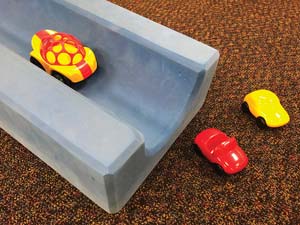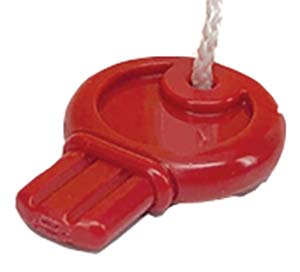Fine motor development
Toddlers practice holding, and then letting go, of a toy vehicle on a ramp.




Be Prepared: Set up two ramps with space for you to kneel between them.

 Invite 3–4 toddlers to join you to play with cars going down a ramp. Open the session by pointing to and naming the ramps. Demonstrate how to use a ramp in this activity by using one hand to pick up and hold a toy car, place it at the top of the ramp, let it go, and watch it roll down. Then invite toddlers, two at a time, to place a vehicle at the top of the ramp, let it go, and watch it roll down.
Invite 3–4 toddlers to join you to play with cars going down a ramp. Open the session by pointing to and naming the ramps. Demonstrate how to use a ramp in this activity by using one hand to pick up and hold a toy car, place it at the top of the ramp, let it go, and watch it roll down. Then invite toddlers, two at a time, to place a vehicle at the top of the ramp, let it go, and watch it roll down.
Help toddlers keep separate (1) the placement of the vehicle at the top of the ramp, and (2) letting it go. Some toddlers may benefit from your verbal support for each step. Example: “Shaun, now you may let go of your car so it can roll down the ramp. Would you like me to say ‘ready, set, go’?” Discourage toddlers from giving the vehicle a push and avoid comparing the two vehicles as they roll. Encourage toddlers to focus on how they use their hand to hold and let go. Example: “You are using your fingers to hold the car. Now your fingers are letting go of the car.”
Toddlers who are watching and eager to have a turn may need a reminder of their forthcoming turn. Example: “We are giving Shaun time to hold and let go of his car. You can use our ramp very soon.”
Emphasizing the separate hand/finger actions involved in this activity— holding/placing the toy vehicle on the ramp and then letting it go—will be a new experience for most toddlers. The activity is intended to foster fine motor skills while providing enjoyment and contributing to self-confidence in manipulating an object that yields an exciting outcome. A prior object-rolling activity (Block 19, Cognitive) focused on problem-solving skills regarding the temporary disappearance of a ball inside a tube and the angle of tubes. Toddlers will be pleased to see the vehicles roll down the ramp in the current activity. Defining the activity as a race, or setting rules, is not suggested.
Some toddlers will be eager to roll a vehicle down the ramp repeatedly. Other toddlers may participate for a short amount of time. While helping toddlers wait for a turn is necessary, establishing an exact turn-taking scheme is impractical. The concept of turn taking takes time to develop.
Some toddlers may be interested in trying to roll other toys down a ramp. This interest might lead a toddler to discover that some toys, such as a soft animal toy, may not slide down a ramp. Consider setting up ramps with small balls as a follow-up activity.
Extra support
Enrichment
Fine motor development
Toddlers move toy vehicles on pretend roads that include curves.




Be Prepared: Include some vehicles that are the same. Place toy vehicles around the edge of the road rug to create interest in vehicle play.
Sit near the rug and invite 2–3 toddlers to join you on the floor. Point to the lines on the rug and explain these are roads we can use for driving our toy trucks and cars. Point to and describe some curves in a road. Demonstrate moving a toy vehicle on part of a road. Include a turn in your demonstration.
Encourage toddlers to drive a toy vehicle on the roads. Describe each toddler’s actions. Example: “Angel, you are turning the little car on the curvy road.” Point to the curvy section of road. Talk with toddlers about how the toy vehicles look the same and different. Example: “Diego, I see you picked a truck to drive on the road. It looks the same as this truck.” Point to a similar truck. Keep a toy vehicle for your own use when a demonstration seems appropriate.
Draw attention to the presence of peers in the gathering. Examples: “We are playing together.” “Playing with friends is fun.” When appropriate, suggest a toddler show another child his/her vehicle. You may wish to introduce the idea of sharing vehicles by trading your vehicle with a toddler. Example: “Thanks Diego. You shared a truck with me.”
Holding and moving a toy vehicle supports small motor coordination. Moving a toy car in a straight line and moving it around a curve or circle require different hand positions. Drawing attention to various details of the road, such as a turns or a roundabout, can help toddlers anticipate different types of movements of a vehicle.
Some toddlers will enjoy moving the toy vehicles along the lines on the rug. Other toddlers may move the vehicles on the floor. Some toddlers will enjoy using their fingers to spin the wheels on the vehicles. Some toddlers will enjoy sorting the vehicles and lining them up on their own.
Some toddlers will enjoy finding two vehicles that are the same. Draw attention to features that make the vehicles the same. It is not necessary to teach the color names to toddlers at this age.
At this age, toddlers do not know how to share toys on their own. Support awareness of others by suggesting spaces toddlers can play without bumping others. Facilitate sharing. Your comments about the vehicle play and attention to toddlers’ actions will help toddlers maintain interest in the activity.
Extra support
Enrichment
Fine motor development
A toddler plays with toy vehicles and a garage with door locks.




Be Prepared: The activity is designed for a toddler who has experience manipulating small toys and seems ready to explore the fine motor skills promoted with use of a key.
 [Invite one toddler to explore the garage and cars with you on a low surface or on the floor. Begin the activity with the garage doors open.
[Invite one toddler to explore the garage and cars with you on a low surface or on the floor. Begin the activity with the garage doors open.
Sit facing the toddler. Point to each garage door while saying its name. Example: “Here is a garage door. Here is a garage door. And here is another garage door. We have a lot of garage doors for the cars!”]
[Encourage the toddler to move toy cars in and out of the garage. Draw attention to the garage doors. Wait to introduce the key.
Describe the toddler’s actions. Example: “You took one car out.”
 Respond to the toddler’s inquiry about the key as soon as he/she notices it. Explain that a key locks and unlocks each garage door. Demonstrate how the key works on one garage door. Emphasize as you demonstrate that we turn the key. Then invite the toddler to try using (turning) the key.
Respond to the toddler’s inquiry about the key as soon as he/she notices it. Explain that a key locks and unlocks each garage door. Demonstrate how the key works on one garage door. Emphasize as you demonstrate that we turn the key. Then invite the toddler to try using (turning) the key.
Provide time for the toddler to explore the key and lock. Offer verbal support and demonstration as needed and when the toddler nods or says “yes” to your question, “Would you like me to help?” Some toddlers may be interested in trying to operate the key without your assistance.
If you demonstrate use of the key, point out specifics. Show the toddler how you are holding the key. Point to the keyhole. Slowly place the key into the keyhole. Then encourage the toddler to turn the key.
Recognize a toddler’s persistence. Examples: “You know the key goes into the hole. You are trying different ways to use the key to open the little door.” “You are working hard to open the garage.”]
You moved cars in and out of the garage. You closed and opened the garage doors. You learned how to hold the key and unlock the little door. You worked hard to put the key into the hole and turn it.
Some toddlers may be fully focused on moving cars in and out of the garage and manipulating the garage doors. Some toddlers may focus mostly on locking and unlocking the garage doors. Both interests support fine motor development. Toddlers are not expected to develop proficiency with a key and lock. What’s important is providing time for an interested toddler to explore and practice. Watch for signs of frustration in working the key, and offer assistance.
Look for parts of a toddler’s play that may benefit from your assistance. The parts include the use of one hand for the following steps: holding a key in one hand, putting a key into a lock hole, turning a key to unlock the door, pulling open a garage door, and removing a car. Offer verbal support or demonstration for the part(s) of the task that seems most challenging to a toddler. Example: “Hold the key (this way) and look at the keyhole.”
Extra support
Enrichment
Materials Needed: board books about vehicles, toy vehicles, tape, building blocks, button box, toy keys
Display books about vehicles together in the room. Place some toy vehicles on a low surface for continued play. Tape lines on the floor or low surfaces for toddlers to follow with toy cars. Foster fine motor skills by inviting toddlers to use connecting building blocks as part of creating structures related to vehicle play.
Materials Needed: toys to hold and shake, nonbreakable dish, toy vehicles, washable paint, paper
In addition to offering Options 1–3, support the fine motor skills of toddlers and preschool-age children by providing toy vehicles that they can drive through washable paint to make tire tracks on paper. Offer age-appropriate toys to infants to hold and shake. Vary the shapes of toys offered to older infants. Also, infants will enjoy taking items out of a nonbreakable dish.